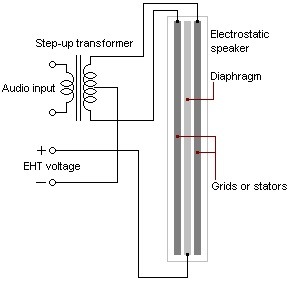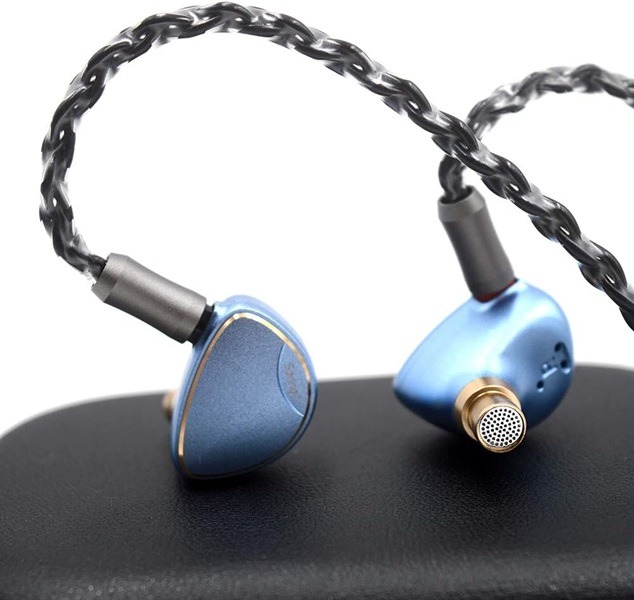
If you’re in the hunt for quality headphones, you’ll be surprised at the many different headphone styles and brands available on the market today. This may make it harder for you to choose the right ones. Headphone specs are complex and very technical and can easily get you confused if you’re only reading them. This guide cuts through the jargon to shed more light on one of the common headphone components, the headphone driver, and how it affects audio quality.
What Is a Headphone Driver?
The driver is the heart of any pair of headphones, responsible for transforming electrical signals into an auditory experience that you can enjoy. Put simply, it produces the sound that reaches your ears. Think of headphone drivers as tiny loudspeakers inside your ear canal.

A driver unit is composed of three main components:
- Magnet – generates a magnetic field that can affect the overall sound quality of the headphones
- Voice coils – move the diaphragm to create the sound you hear when an electric current passes through them
- Diaphragm – vibrates to create sound waves that human ears can pick up
A headphone driver is usually disc-shaped, and the size varies depending on the make and required sound output.
Good to know: learn how to fix only one side of your headphones working on a Windows PC.
Types of Headphone Drivers
As mentioned earlier, the type of driver used in earphones influences the quality of sound that comes out of the audio device. Listed below are the various types of drivers commonly used in earphones and headphones.
1. Dynamic (Moving Coil) Drivers
Dynamic drivers boast the most straightforward configuration of all driver types discussed here. They use a magnet, typically a neodymium, with a magnetic field that interacts with the voice coil. When an electric current activates the voice coil, it engages in rhythmic oscillation, inducing the diaphragm to participate in synchronized resonance.

Despite dynamic drivers being highly effective, one of the biggest complaints against them is that they can produce harmonic distortion at louder volumes. Fortunately, the effect can be countered by good engineering.
Dynamic drivers are usually the norm when it comes to lower-end, cheaper headphones, but they are also often used in higher-end models, such as the Sennheiser HD 800S.
2. Planar Magnetic Drivers
These are the driver types you’ll find in most of the high-end headphones in the market today. While usually found in open-back, over-ear headphones, some in-ear models are also available.

In this technology, a diaphragm is sandwiched between magnets. Much like dynamic drivers, planar magnetic drivers function through the manipulation of a magnetic field. However, instead of relying on a coil, these drivers utilize the thin, flat diaphragm that directly responds to the magnetic field, producing sound as a result.
These drivers produce a very accurate and clean sound, giving you every bit of detail, without adding too many sound effects or other modifications. You’ll find them in most high-end headphones, such as the Audeze LCD-5.
Tip: learn how to make your headphones louder on any device.
3. Balanced Armature Drivers
These are very small drivers, and their typical use is with in-ear monitors. Due to their size, manufacturers can opt to add multiple drivers in a single earpiece. Typically, most in-ear monitors have one to four drivers.

This type of driver consists of a coil wrapped around a miniature arm (armature). Two magnets flank the armature. When an electric current flows through the coil, it generates a magnetic field that interacts with these magnets, causing the armature to oscillate. Since the diaphragm is connected to the armature, it will move synchronously with the latter, thus producing sound waves. When the armature becomes centered within the magnetic field, there’s no net force applied to the armature, which gives it its “balanced armature” name.
One major downside of balanced armature drivers compared to dynamic drivers is that they have difficulty reproducing the bass response. This is why it’s not uncommon for some in-ear monitors to include multiple balanced armature drivers and a dynamic driver, as the latter makes up for the lack of bass response. One such product is the 1More Triple Driver In-Ear headphones.
4. Electrostatic Drivers
These are rare and extremely expensive. Like charges, electrostatic drivers operate, based on repelling each other while opposite ones attract. Vibrations are produced as the diaphragm pushes and pulls against two conductive plates (that may be positively or negatively charged) or two electrodes. The diaphragm drives the air through the perforated walls, and in conjunction with the fluctuating electrical signal, generates sound waves.

These are drivers that require special amplifiers to perform to their full potential. Thus, you’ll find this type of driver in high-end headphones that usually sport an open-back design.
They produce exceptional sound quality with breathtaking accuracy. For this reason, they have a hefty price tag and are only found in premium headsets, like the STAX SR-X9000 flagship model.
Tip: iPhone users should check out Beats headphone alternatives.
5. Piezoelectric Drivers
Not to be confused with electrostatic drivers, piezoelectric drivers are a unique type of driver that has made it into some modern hybrid headphone models, such as the KyaMuc BQEYZ Summer.

Piezoelectric drivers operate by having piezoelectric material (usually crystal or ceramic) sandwiched between two electrodes. When an electrical signal is applied across the electrodes, the piezoelectric material either expands or contracts, depending on the polarity of the signal. This mechanical deformation produces sound waves using the diaphragm.
What’s great about these drivers is the capability to convert even the weakest audio signal into sound, reproducing it with clarity and reality. Manufacturers can do only limited fine-tuning of these drivers, due to the nature of the piezoelectric materials. This can result in low-quality sound and large power consumption.
6. Bone Conduction Drivers
These drivers are capable of transferring vibrations directly to the user’s inner ear (bypassing the eardrum) via bone conduction. Headphones equipped with this driver type are designed for users who require situational awareness, allowing them to remain aware of environmental sounds while using the headphones, or users who have hearing impairments.

However, with bone conduction drivers, you’ll certainly be trading usability for quality. This category is currently no match for the other types of drivers with regard to the delivery of high-class sound.
However, more and more bone conduction headphones are being released, including affordable models such as those offered by ECOAMICA. For more suggestions, check out our bone conduction headphones guide.
How Headphone Drivers Affect Audio Quality
Many factors come into play when it comes to the sound quality of headphones. We tackle some of the key aspects below.
Driver Size
A standard earphones driver is usually in the range of 8mm to 15mm in diameter, while a headphones driver ranges from 20mm to 50mm in diameter. Generally, a driver’s size determines the loudness of the headphones.
Many believe the bigger the size, the better the sound quality. This is not entirely true, although due to a larger diaphragm, the bass may be a little cleaner. Headphones with large drivers also tend to struggle to reproduce high frequencies (treble).
While bigger drivers are capable of producing higher output, this doesn’t mean they deliver overall better output. It’s the quality of the driver unit and the variation of materials inside that makes a huge difference. Take Google’s Pixel Buds as an example. These earbuds are quite small with very small drivers, yet they produce sound quality that rivals other brands with larger drivers.
FYI: in the market for a new pair of headphones for working out? See this list of the best budget models.
Driver Unit Enclosure & Tuning
Audio Technica is another example of headphone drivers determining audio quality. This company makes two high-end headphone models: the M40X and the M50X. The M40X uses 40mm drivers, while the M50X uses 45mm drivers. While you may assume that the M50X produces better sound due to its larger drivers, that’s not necessarily true.
The headphones are tuned very differently. The M50X has tuning, pads, and enclosures designed for a slightly aggressive response, while the M40X is designed around a flatter and more neutral signature. In both cases, the type of padding used and the enclosure of the cup have a larger impact on the sound than the drivers used.
In a nutshell, the size of the driver does affect the output and the frequency range of headphones. However, you should not base your buying decision on the size of the drivers alone. There are other factors, such as the type of drivers or padding used, that affects the quality of sound more than the size of the drivers used.
Quality of Drivers
Just as with driver size, having multiple drivers (per side) on board a pair of headphones does not guarantee better sound.
Multiple driver headphones use each driver to manage a specific range of frequencies, including audio bass, mids, treble, etc. On paper, that should be enough to get improved sound quality, but a poorly produced multi-driver unit will always perform worse than a high-end single driver.
As driver technology has recently become more capable, and our understanding of headphone sound tuning has improved, using multiple drivers is no longer an absolute necessity. It’s possible to get better sound from headphones featuring a single type of drive.
Tip: if you’re going on a trip soon, it may be useful to learn how to use your own headphones for in-flight entertainment.
Which Headphone Driver Should I Choose?
The choice of headphones boils down to your personal preferences and what you’re going to use them for. If you’re a party lover and want something that delivers quite a punch, to immerse yourself into the atmosphere in no time, go for the headphones with dynamic drivers. These do a stellar job when it comes to delivering powerful bass and attaining good sound pressure without consuming much power.

But if you intend to use the headphones solely for gaming, you most likely won’t care much about the bass or the mid-lows. In this case, audio devices with balanced armature drivers should be a good choice. If you usually listen to music while out and about, you may want to look at models with bone conducting drivers, as they promote spatial awareness.
If you’re an audiophile, you probably don’t need our advice on what headsets to buy, but we’re offering it anyway. Go for planar magnetic drivers. If budget is not a constraint, headphones with electrostatic drivers will satisfy your curiosity more. But if you’re working in a specialized field, where high-frequency accuracy is crucial, such as audio engineering or certain aspects of music production, you may benefit from the specific sound profile of piezoelectric drivers.
You can apply all you’ve learned about headphone drivers while looking for your next purchase. Interested in buying noise-canceling headphones in 2024? Check out this guide. It may also be handy to learn how to safely clean your earbuds and headphones to prolong their life cycle.
Image credit: Pexels
Our latest tutorials delivered straight to your inbox